TO
1 - 200 of 177
| Creator | Title | Description | Subject | Date | ||
|---|---|---|---|---|---|---|
| 1 |
 | Durney, Carl H. | A computer graphics method for solving transcendental equations | There are a number of ways to determine the values of x which satisfy the equation F(x)=0. (The case of interest here is that in which F i s a complex function of the complex variable x.) One way is to search for values of x which make Real (F(x)) and Imaginary (F(x)) both zero at the same time wher... | Transcendental equations | 1970 |
| 2 |
 | Normann, Richard A. | Acute human brain responses to intracortical microelectrode arrays: challenges and future prospects | The emerging field of neuroprosthetics is focused on the development of new therapeutic interventions that will be able to restore some lost neural function by selective electrical stimulation or by harnessing activity recorded from populations of neurons. As more and more patients benefit from thes... | 2014-01-01 | |
| 3 |
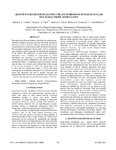 | Normann, Richard A. | Adaptive parameter selection for asynchronous intrafascicular multi-electrode stimulation | This paper describes an adaptive algorithm for selecting perelectrode stimulus intensities and inter-electrode stimulation phasing to achieve desired isometric plantar-flexion forces via asynchronous, intrafascicular multi-electrode stimulation. The algorithm employed a linear model of force product... | 2012-01-01 | |
| 4 |
 | Normann, Richard A.; Jones, Kelly E. | Advanced demultiplexing system for physiological stimulation | A CMOS very large scale integration (VLSI) chip has been designed and built to implement a scheme developed for multiplexing/demultiplexing the signals required to operate an intracortical stimulating electrode array. Because the use of radio telemetry in a proposed system utilizing this chip may im... | Electrode Array; Stimulation; Telemetry; Microelectrodes; Transistors | 1997 |
| 5 |
 | Durney, Carl H. | An experiment in using interactive computer graphics in teaching transient transmission-line theory | An interactive computer graphics routine was developed and used in teaching EE 553, Electromagnetic Fields, autumn quarter, 1969, in the Electrical Engineering Department of the University of Utah. The routine displayed the propagation of the voltage ave form produced by a step-function generator do... | 1970 | |
| 6 |
 | Gouw, Launce G.; McKenna, Catherine K.; Digre, Kathleen B.; Placek, Louis J. | Analysis of the dynamic mutation in the SCA7 gene shows marked parental effects on CAG repeat transmission. | The gene for spinocerebellar ataxia 7 (SCA7) includes a transcribed, translated CAG tract that is expanded in SCA7 patients. We have determined expansions in 73 individuals from 17 SCA7 kindreds and compared them with repeat lengths of 180 unaffected individuals. Subjects with abnormal expansions co... | Genetics; Biosynthesis; SCA7 Gene | 1998-03-07 |
| 7 |
 | Baehr, Wolfgang | Annotation and analysis of 10,000 expressed sequence tags from 3 mouse eye cDNA libraries | BACKGROUND: As a biomarker of cellular activities, the transcriptome of a specific tissue or cell type during development and disease is of great biomedical interest. We have generated and analyzed 10,000 expressed sequence tags (ESTs) from three mouse eye tissue cDNA libraries: embryonic day 15.5 (... | Cluster Analysis; DNA, Complementary; Gene Expression Profiling | 2003 |
| 8 |
 | Kriesel, John D.; Maulden, Sarah Annamarie; Spruance, Spotswood L. | Anti-interleukin-6 antibodies inhibit herpes simplex virus reactivation. | Herpes simplex viruses (HSVs) infect epithelial cells, become localized in neurons, and can reactivate in response to a variety of stimuli, including ultraviolet light and hyperthermia. The sequence of gene activation during viral replication is known, but the molecular linkage between exogenous sti... | Mice, Inbred BALB C; Tumor Necrosis Factor-alpha; Virus Activation | 1997 |
| 9 |
 | Digre, Kathleen B.; Gouw, Launce G.; Harris, Catherine P.; Haines, John H.; Ptacek, L.J. | Autosomal dominant cerebellar ataxia with retinal degeneration: clinical, neuropathologic, and genetic analysis of a large kindred. | The autosomal dominant cerebellar ataxias (ADCA) comprise a heterogeneous group of neurologic disorders characterized by degeneration of the cerebellum, spinal cord, and brainstem. Genetic analysis has revealed two loci, SCA1 on chromosome 6p, and SCA2 on chromosome 12q, responsible for some ADCA. W... | Retinal Degeneration; Cerebellar Ataxia; Genetic Analysis | 1994-08 |
| 10 |
 | Baehr, Wolfgang; Katz, Bradley J.; Creel, Donnell J.; Zhang, Kang | Autosomal dominant cone dystrophy caused by a novel mutation in the GCAP1 gene (GUCA1A) | PURPOSE: To describe the clinical features and genetic analysis of a family with an autosomal dominant cone dystrophy (adCD). METHODS: Selected members of a family with an autosomal dominant cone dystrophy underwent ophthalmic evaluation. Blood samples were obtained, genomic DNA was isolated, and ge... | Mutation, Missense; DNA Mutational Analysis; Electroretinography | 2005 |
| 11 |
 | Normann, Richard A. | Background and bleaching adaptation in luminosity type horizontal cells in the isolated turtle retina | 1. The effects of background illumination and bleached photopigment on luminosity type horizontal cells were studied in the isolated turtle retina. 2. Background illumination, which produced less than 60% bleaching, hyperpolarized and desensitized the horizontal cells to a degree which depended upon... | Turtles; Retina; Photoreceptors; Bleached photopigment; Dark Adaptation | 1990 |
| 12 |
 | Baehr, Wolfgang | Bilateral retinal and brain tumors in transgenic mice expressing simian virus 40 large T antigen under control of the human interphotoreceptor retinoid-binding protein promoter | We have previously shown that postnatal expression of the viral oncoprotein SV40 T antigen in rod photoreceptors (transgene MOT1), at a time when retinal cells have withdrawn from the mitotic cycle, leads to photoreceptor cell death (Al-Ubaidi et al., 1992. Proc. Natl. Acad. Sci. USA. 89:1194-1198).... | Simian virus 40; Retinol-Binding Proteins; Promoter Regions (Genetics) | 1992 |
| 13 |
 | Bernstein, Paul S. | Biochemical characterization of the retinoid isomerase system of the eye | We have previously shown that membranes from the retinal pigment epithelium can transform added all-trans-retinol into a mixture of 11-cis-retinoids, demonstrating the "missing reaction" in the visual cycle for the first time (Bernstein, P. S., Law, W. C., and Rando, R. R. (1987) Proc. Natl. Acad. S... | Hydrogen-Ion Concentration | 1987 |
| 14 |
 | Baehr, Wolfgang | Calcium-sensitive particulate guanylyl cyclase as a modulator of cAMP in olfactory receptor neurons | The second messengers cAMP and inositol-1,4,5-triphosphate have been implicated in olfaction in various species. The odorant-induced cGMP response was investigated using cilia preparations and olfactory primary cultures. Odorants cause a delayed and sustained elevation of cGMP. A component of this c... | Calcium-Binding Proteins; Nerve Tissue Proteins; Rats, Sprague-Dawley | 1998 |
| 15 |
 | Baehr, Wolfgang | Calcium-sensitive regions of GCAP1 as observed by chemical modifications, fluorescence, and EPR spectroscopies | Guanylyl cyclase-activating proteins are EF-hand Ca(2+)-binding proteins that belong to the calmodulin superfamily. They are involved in the regulation of photoreceptor membrane-associated guanylyl cyclases that produce cGMP, a second messenger of vertebrate vision. Here, we investigated changes in ... | Amino Acid Motifs; Cyclic N-Oxides; EF Hand Motifs | 2001 |
| 16 |
 | Digre, Kathleen B.; Blumenthal, Deborah T.; Cessna, Melissa H.; Gopez, Evelyn V.; Shen, Yue | Carcinomatous meningitis as the presenting manifestation of gallbladder carcinoma: case report and review of the literature | The primary tumors that typically cause carcinomatous meningitis include lung cancer, breast cancer, leukemia, lymphoma and melanoma. A variety of neurological signs and symptoms can be seen depending on the extent and location of the meningeal metastasis. Once the diagnosis of carcinomatous meningi... | Carcinomatous Meningitis; Gallbladder Carcinoma; Leptomeningeal Metastasis; Meningeal Carcinomatosis; Cranial Neuropathy | 2004-10 |
| 17 |
 | Olson, Randall J.; Crandall, Alan S.; Pingree, Michael F. | Cataract surgery complications in 1 year at an academic institution | PURPOSE: To delineate all complication rates of cataract surgery and define normative rates, trends, and outliers as part of continuous quality management. SETTING: John A. Moran Eye Center, University of Utah Health Sciences Center, Salt Lake City, Utah, USA. METHODS: All cataract surgeries done at... | Intraoperative Complications/Epidemiology; Adverse Effects; Cataract Surgery | 1999-05 |
| 18 |
 | Jaeckle, Kurt A.; Digre, Kathleen B.; Jones, Christopher R.; Bailey, Peter L. | Central neurogenic hyperventilation: pharmacologic intervention with morphine sulfate and correlative analysis of respiratory, sleep, and ocular motor dysfunction. | Central neurogenic hyperventilation (CNH), for which there is no effective therapy, can eventually result in respiratory fatigue and death. This report describes a patient with CNH due to a brainstem anaplastic astrocytoma who also exhibited disturbances of sleep and ocular motor function. The CNH r... | Central Neurogenic H yperventilation; Ocular Motor Dysfunction | 1990-11 |
| 19 |
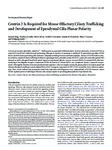 | Frederick, Jeanne M. | Centrin 2 is required for mouse olfactory ciliary trafficking and development of ependymal cilia planar polarity | Centrins are ancient calmodulin-related Ca2-binding proteins associated with basal bodies. In lower eukaryotes, Centrin2 (CETN2) is required for basal body replication and positioning, although its function in mammals is undefined. We generated a germline CETN2 knock-out (KO) mouse presenting with s... | 2014-01-01 | |
| 20 |
 | Bernstein, Paul S.; Zabriskie, Norman A.; Zhang, Kang | CFH Y402H Confers similar risk of soft Drusen and both forms of advanced AMD | BACKGROUND: Age-related macular degeneration (AMD) is the most common cause of irreversible visual impairment in the developed world. The two forms of advanced AMD, geographic atrophy and neovascular AMD, represent different pathological processes in the macula that lead to loss of central vision. S... | 2005 | |
| 21 |
 | Baehr, Wolfgang | Characterization of bovine rod outer segment G-protein | A simple modified procedure is described for isolating and purifying peripherally bound membrane proteins from bovine rod outer segment disks. The methods yield milligram quantities of G-protein and cGMP phosphodiesterase which are suitable for reconstitution with membranes containing visual pi... | Heterotrimeric GTP-Binding Proteins; Macromolecular Substances; Rhodopsin | 1982 |
| 22 |
 | Baehr, Wolfgang; Zhang, Kang | Characterization of human GRK7 as a potential cone opsin kinase | PURPOSE: Homozygous inactivation of the mouse gene for GRK1 (G protein-coupled receptor kinase 1, or rhodopsin kinase) causes severe defects in the recovery of cone phototransduction. However, electroretinographic (ERG) analyses of human oguchi patients with defective GRK1 alleles showed normal or s... | Amino Acid Sequence; Chromosomes, Human, Pair 3; Fluorescent Antibody Technique, Indirect | 2001 |
| 23 |
 | Baehr, Wolfgang | Characterization of the chicken GCAP gene array and analyses of GCAP1, GCAP2, and GC1 gene expression in normal and rd chicken pineal | PURPOSE: This study had three objectives: (1) to characterize the structures of the chicken GCAP1 and GCAP2 genes; (2) to determine if GCAP1, GCAP2, and GC1 genes are expressed in chicken pineal gland; (3) if GC1 is expressed in chicken pineal, to determine if the GC1 null mutation carried by the re... | Molecular Sequence Data; Promoter Regions (Genetics); Retinal Degeneration | 1999 |
| 24 |
 | Angelucci, Alessandra; Lund, Jennifer S. | Circuits for local and global signal integration in primary visual cortex | Contrast-dependent changes in spatial summation and contextual modulation of primary visual cortex (V1) neuron responses to stimulation of their receptive field reveal long-distance integration of visual signals within V1, well beyond the classical receptive field (cRF) of single neurons. To identif... | Primary Visual Cortex; Extrastriate Cortex; Feed-back Connections; Lateral Connections; SUrround Modulation; Macaque | 2002-10-01 |
| 25 |
 | Olson, Randall J. | Clinical comparison of single-piece and three-piece truncated hydrophobic acrylic intraocular lenses | PURPOSE: To determine the clinical differences between three-piece (3P) and single-piece (SP) truncated hydrophobic acrylic intraocular lenses (IOL). DESIGN: Retrospective cohort clinical study. METHODS: The setting was an academic clinical practice. The patient population consisted of subjects with... | Lenses, Intraocular; Patient Satisfaction; Postoperative Complications; Prosthesis Design; Visual Acuity | 2003-10 |
| 26 |
 | Olson, Randall J. | Clinical experience with 21-gauge manual microphacoemulsification using Sovereign WhiteStar Technology in eyes with dense cataract | PURPOSE: To present a series of patients who had 21-gauge microphacoemulsification using Sovereign WhiteStar technology. SETTING: John A. Moran Eye Center, University of Utah School of Medicine, Salt Lake City, Utah, USA. METHODS: Eighteen consecutive patients with cataracts judged to be 3+ or 4+ on... | Cataract; Microsurgery; Phacoemulsification; Postoperative Complications; Visual Acuity | 2004-01 |
| 27 |
 | Baehr, Wolfgang | Cloning and molecular characterization of cGMP-gated ion channels from rod and cone photoreceptors of striped bass ( M. saxatilis ) retina | Vertebrate photoreceptors respond to light with changes in membrane conductance that reflect the activity of cyclic-nucleotide gated channels (CNG channels). The functional features of these channels differ in rods and cones; to understand the basis of these differences we cloned CNG channels from t... | Amino Acid Sequence; Computational Biology; Reverse Transcriptase Polymerase Chain Reaction | 2006 |
| 28 |
 | Baehr, Wolfgang | Cloning and sequence analysis of the major outer membrane protein genes of two Chlamydia psittaci strains | We cloned and sequenced the gene encoding the major outer membrane protein (MOMP) of two Chlamydia psittaci strains, guinea pig inclusion conjunctivitis (GPIC) strain 1, and meningopneumonitis (Mn) strain Cal-10. Intraspecies alignment of the two C. psittaci MOMP genes revealed 80.6% similarity, and... | Base Sequence; Cloning, Molecular; Amino Acid Sequence | 1989 |
| 29 |
 | Baehr, Wolfgang | Cloning of frog rod photoreceptor cGMP phosphodiesterase subunits (P-alpha, P-beta, P-gamma) and identification of P-gamma) sites involved in the stimulation of cGMP binding to P-alpha and P-beta non-catalytic sites | Retinal cGMP phosphodiesterase (PDE6) is a key enzyme in vertebrate phototransduction. Rod PDE contains two homologous catalytic subunits (Pd two identical regulatory subunits (P). Biochemical studies have shown that amphibian P has high affinity, cGMP-specific, non-catalytic binding sites and that ... | Phototransduction; Retinal cGMP phosphodiesterase; Amphibian PDE | 2002 |
| 30 |
 | Normann, Richard A.; Shoham, Shy | Coding of position by simultaneously recorded sensory neurones in the cat dorsal root ganglion | Muscle, cutaneous and joint afferents continuously signal information about the position and movement of individual joints. How does the nervous system extract more global information, for example about the position of the foot in space? To study this question we used microelectrode arrays to record... | Cats; Sensory Neurones; Movement; Limb Position | 2004 |
| 31 |
 | Olson, Randall J. | Cohort study of 27 cases of endophthalmitis at a single institution | PURPOSE: To identify potential risk factors associated with post-cataract surgery bacterial endophthalmitis. SETTING: The John A. Moran Eye Center, Salt Lake City, Utah, USA. METHODS: This retrospective cohort study consisted of patients who had surgery for cataract(s) at this eye hospital. A 10% sa... | Cataract Extraction; Endophthalmitis; Wound Healing; Risk Factors | 2005-04 |
| 32 |
 | Olson, Randall J. | Comparison of patient satisfaction after uncomplicated cataract surgery between the silicone AMO SI-30/40 and the acrylic Alcon MA30BA and MA60BA foldable intraocular lenses | PURPOSE: To compare patient satisfaction with vision 12 months after implantation of a silicone or acrylic foldable intraocular lens (IOL). SETTING: John A. Moran Eye Center, University of Utah Medical Center, Salt Lake City, Utah, USA. METHODS: Selection criteria included patients who had uneventfu... | Patient Satisfaction; Lenses, Intraocular; Silicone Elastomers; Biocompatible Materials | 2001-10 |
| 33 |
 | Olson, Randall J. | Comparison of the effects of viscoelastic agents on clinical properties of the Unfolder lens injection system | PURPOSE: To evaluate the effect of 7 viscoelastic materials on the physical properties of the Unfolder lens injection system. SETTING: John A. Moran Eye Center, University of Utah School of Medicine, Salt Lake City, Utah, USA. METHODS: New sterile SI-40NB intraocular lenses (IOLs) were loaded into t... | Lenses, Intraocular; Materials Testing; Hyaluronic Acid; Equipment Failure Analysis | 1999-07 |
| 34 |
 | Olson, Randall J. | Comparison of thermal features associated with 2 phacoemulsification machines | PURPOSE: To determine the thermal characteristics of the Legacy Advantec and Sovereign WhiteStar phacoemulsification machines during different clinically relevant scenarios. SETTING: In vitro study. METHODS: In water, temperature was recorded continuously on the sleeve in an artificial chamber, and ... | Cataracts; Wound Burns; Thermal Characteristics | 2006-02 |
| 35 |
 | Digre, Kathleen B.; Schmidt, Richard H.; Osborne, Anne G.; Patel, Bhupendra C.; Pratt, David; Rietz, Lisa A. | Compressive optic neuropathy caused by renal osteodystrophy. Case report. | Compressive optic neuropathy with acute or chronic vision loss has been associated with various skull base tumors, aneurysms, Graves disease, trauma, and, less commonly, fibrous dysplasia and osteopetrosis. The Author's present a case of acute visual deterioration in a 25-year-old woman who had mass... | Optic Neuropathy; Optic Nerve Decompression; Renal Osteodystrophy | 2001-10 |
| 36 |
 | Normann, Richard A. | Control of retinal sensitivity. I. Light and dark adaptation of vertebrate rods and cones | Rods and cones in Necturus respond with graded hyperpolarization to test flashes spanning about 3.5 log units of intensity. Steady background levels hyperpolarize the rods, and the rod responses become progressively smaller as background level is increased. In cones, higher background levels reduce... | Retina;Light and Dark Adaptation; Recepters; Bipolars; Ganglion Cells | 1974 |
| 37 |
 | Kriesel, John D.; Baringer, J R; Spruance, Spotswood L. | Correlation between detection of herpes simplex virus in oral secretions by PCR and susceptibility to experimental UV radiation-induced herpes labialis. | We examined the oral secretions of 25 patients for herpes simplex virus (HSV) at the time of and following experimental UV radiation (UVR). HSV was detected in one or more oral secretion specimens in 5 of 12 (42%) cases by cell culture and in 8 of 12 (67%) cases by PCR. On the day of UVR, HSV was de... | Polymerase Chain Reaction; Ultraviolet Rays; Simplexvirus | 1994 |
| 38 |
 | Varner, Michael W.; Digre, Kathleen B. | Cranial magnetic resonance imaging in eclampsia. | Although the precise neuropathologic basis for eclamptic convulsions remains unclear, intracranial hemorrhage is frequently associated with fatal cases. Magnetic resonance imaging (MRI) is a recently developed neuroimaging technique that appears superior to other processes for defining intracranial ... | Eclampsia; Brain Edema; Cranial Magnetic Resonance Imaging | 1987-09 |
| 39 |
 | Digre, Kathleen B. | CT and hemifacial spasm. | Forty-six patients with typical hemifacial spasm had CT. Thirty-eight (83%) were abnormal, including two with surgically documented tumors. Thirty-six had a characteristic dolichoectatic vertebrobasilar artery, with the convexity pointing to the side of the spasm in 92% of the scans. This study sugg... | Hemifacial spasms; Tumors; Dolichoectiatic vertebrobasilar artery | 1988-07 |
| 40 |
 | Bernstein, Paul S.; Zabriskie, Norman A.; Zhang, Kang; Leppert, Mark F. | Diverse macular dystrophy phenotype caused by a novel complex mutation in the ELOVL4 gene | PURPOSE: A 5-bp deletion in ELOVL4, a photoreceptor-specific gene, has been associated with autosomal dominant (ad) macular dystrophy phenotypes in five related families, in which phenotypes range from Stargardt-like macular dystrophy (STGD3; Mendelian Inheritance in Man 600110) to pattern dystrophy... | Linkage (Genetics); Middle Older people; Phenotype | 2001 |
| 41 |
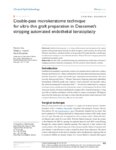 | Moshirfar, Majid | Double-pass microkeratome technique for ultra-thin graft preparation in Descemet's stripping automated endothelial keratoplasty | Endothelial keratoplasty is evolving with increased attention placed on the optical qualities of the posterior donor lenticule. In efforts to improve visual outcomes, the effects of the thickness, smoothness, and planar profile are being studied. This paper describes a double-pass microkeratome tech... | 2012-01-01 | |
| 42 |
 | Olson, Randall J. | Early experiences with microphaco | Microphaco is the separation of irrigation from aspiration that allows removal of cataracts through sub-2mm incisions. While proven intraocular lenses (IOLs) are not available at this time to take advantage of the small wounds, these wounds are advantageous from a separating irrigation standpoint w... | Microphaco; Cataracts; Irrigation; Wounds | 2004 |
| 43 |
 | Digre, Kathleen B.; Blumenthal, Deborah T.; Salzman, Karen L.; Jensen, Randy L.; Dunson, William A. | Early pathologic findings and long-term improvement in anti-Ma2-associated encephalitis. | A 67-year-old man sequentially developed anti-Ma2-associated paraneoplastic encephalitis (PNE) and contralateral herpes simplex encephalitis (HSE). Brain biopsy 1 month before HSE revealed extensive infiltrates of T cells, B cells, and plasma cells. Most T cells expressed the cytotoxic granule-assoc... | Paraneoplastic neurologic disorders; Encephalitis; Neoplasm;Herpes Simplex | 2006-07-11 |
| 44 |
 | Digre, Kathleen B.; Blumenthal, Deborah T.; Salzman, Karen L.; Jensen, Randy L.; Dunson, William A. | Early pathologic findings and long-term improvement in anti-Ma2-associated encephalitis. | A 67-year-old man sequentially developed anti-Ma2-associated paraneoplastic encephalitis (PNE) and contralateral herpes simplex encephalitis (HSE). Brain biopsy 1 month before HSE revealed extensive infiltrates of T cells, B cells, and plasma cells. Most T cells expressed the cytotoxic granule-assoc... | Paraneoplastic neurologic disorders; Encephalitis; Neoplasm;Herpes Simplex | 2006-07-11 |
| 45 |
 | Olson, Randall J. | Effect of lens edge design versus anterior capsule overlap on posterior capsule opacification | PURPOSE: To determine whether lens edge design or anterior capsule overlap on the intraocular lens (IOL) has greater effect on posterior capsule opacification (PCO). DESIGN: Retrospective cohort clinical study. METHODS: Retrospective. SETTING: Academic clinical practice. PATIENT POPULATION: The pati... | Posterior Capsular Opacification' Intraocular Lens; Anterior Capsular Opacification; Acrylic Lenses; Silicone Lenses | 2004-10 |
| 46 |
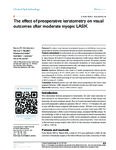 | Moshirfar, Majid | The effect of preoperative keratometry on visual outcomes after moderate myopic LASIK | The relationship between preoperative keratometry (K) and visual outcomes in laser-assisted in situ keratomileusis (LASIK) has been studied in high myopia and hyperopia, but not in moderate myopia. Rao et al report increased undercorrection in eyes with preoperative spherical equivalent (SE) of −1... | 2012-01-01 | |
| 47 |
 | Normann, Richard A. | Effects of background illumination on the photoresponses of red and green cones | 1. The photoresponses of light- and dark-adapted red and green cone photoreceptors were recorded intracellularly in the retina of the turtle, Pseduemys scripta elegans. Background illumination produced similar effects on both types of cones. 2. In response to the onset of a prolonged, steady backgro... | Turtles; Adaptation, Ocular; Retina; Signal Transmission | 1979 |
| 48 |
 | Normann, Richard A.; Chandler, John P. | Effects of calcium ions on L-type horizontal cells in the isolated turtle retina | A technique by which the retina can be isolated from the turtle eye is described. Scanning electron microscopy revealed morphological variability between preparations and also between regions of the same one. Large areas were often totally free of any pigment epithelial cells, yet contained a high p... | Retina; Calcium; Horizontal Cell; Turtle | 1990 |
| 49 |
 | Normann, Richard A. | Effects of GABA and related drugs on horizontal cells in the isolated turtle retina | The role of GABA in the outer plexiform layer of the turtle retina has been examined by intracellular recordings from L- and C-type horizontal cells in the isolated retina preparation. GABA (1-5 mM) slightly depolarized the L-type horizontal cells, reduced the amplitude of their photoresponses, and ... | Retina; Horizontal Cells; Synapse; Negative Feedback; GABA; Turtle | 1990 |
| 50 |
 | Olson, Randall J. | Efficacy and wound-temperature gradient of WhiteStar technology phacoemulsification through a 1.2 mm incision | PURPOSE: To evaluate the efficacy and wound-temperature gradients of WhiteStar micropulse technology using bimanual phacoemulsification without an irrigation sleeve through a 1.2 mm incision. SETTING: Island Eye Surgicenter, Carle Place, New York, USA. METHODS: Ten patients had bimanual phacoemulsif... | Endothelium, Corneal; Surgical Procedures; Lens Implantation; Wound Temperature gradient | 2003-06 |
| 51 |
 | Baehr, Wolfgang; Zhang, Kang | Elovl4 mRNA distribution in the developing mouse retina and phylogenetic conservation of Elovl4 genes | PURPOSE: Stargardt-like macular dystrophy (STGD3) is an autosomal dominant form of early onset macular degeneration. The disease causing gene ELOVL4 encodes a protein that belongs to a family of proteins functioning in elongation of long chain fatty acids. The purpose of this study is to characteriz... | Amino Acid Sequence; Cloning, Molecular; Molecular Sequence Data | 2003 |
| 52 |
 | Normann, Richard A.; Shoham, Shy | Encoding mechanisms for sensory neurons studied with a multielectrode array in the cat dorsal root ganglion | Recent advances in microelectrode array technology now permit a direct examination of the way populations of sensory neurons encode information about a limb's position in space. To address this issue, we recorded nerve impulses from about 100 single units simultaneously in the L6 and L7 dorsal root ... | Sensory; Encoding; Multielectrode; Dorsal Root Ganglion; Cutaneour; Muscle | 2004 |
| 53 |
 | Baehr, Wolfgang | Evaluation of the 17 kda prenyl binding protein as a regulatory protein for phototransduction in retinal photoreceptors | The mammalian rod photoreceptor phosphodiesterase (PDE6) holoenzyme is isolated in both a membrane-associated and a soluble form. Membrane binding is a consequence of prenylation of PDE6 catalytic subunits, whereas soluble PDE6 is purified with a 17-kDa prenyl-binding protein (PDEdelta) tightly boun... | Amino Acid Sequence; Immunohistochemistry; Phosphoric Diester Hydrolases | 2005 |
| 54 |
 | Bernstein, Paul S. | Evaluation of the G protein coupled receptor-75 (GPR75) in age related macular degeneration | 2001 | ||
| 55 |
 | Angelucci, Alessandra | Experimentally induced retinal projections to the ferret auditory thalamus: development of clustered eye-specific patterns in a novel target | We have examined the relative role of afferents and targets in pattern formation using a novel preparation, in which retinal projections in ferrets are induced to innervate the medial geniculate nucleus (MGN). We find that retinal projections to the MGN are arranged in scattered clusters. Clusters a... | Retina; Ferrets | 1997 |
| 56 |
 | Baehr, Wolfgang | Expression and mutagenesis of mouse rod photoreceptor cGMP phosphodiesterase | Using recombinant baculovirus vectors, the three subunits of mouse rod photoreceptor cGMP phosphodiesterase (PDE) (alpha beta gamma 2) have been expressed in insect cells. The recombinant alpha,beta subunits accumulate to 5 mg/liter culture, but most (98%) of the expressed polypeptides are insoluble... | Electrophoresis, Polyacrylamide Gel; Macromolecular Substances; Protein Processing, Post-Translational | 1994 |
| 57 |
 | Fuhrmann, Sabine | Expression of CNTF receptor-alpha in chick violet-sensitive cones with unique morphologic properties. | PURPOSE: Application of ciliary neurotrophic factor (CNTF) can rescue mature photoreceptors from lesion-induced and hereditary degeneration. In the chick retina, expression of the CNTF receptor is present in a subpopulation of photoreceptor cells. The present study was undertaken to identify the CNT... | embryology; cytology | 2004 |
| 58 |
 | Zhang, Kang | Expression of wild type and mutant ELOVL4 in cell culture: subcellular localization and cell viability | PURPOSE: ELOVL4 is a member of the fatty acid elongase (ELO) family of genes. Mutations of this gene are responsible for autosomal dominant Stargardt-like macular degeneration. However, the specific role of ELOVL4 in photoreceptor cells and the mechanism by which mutations in ELOVL4 causes macular d... | Endoplasmic Reticulum; Green Fluorescent Proteins; Microscopy, Fluorescence | 2004 |
| 59 |
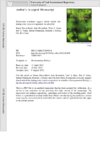 | Fuhrmann, Sabine | Extraocular ectoderm triggers dorsal retinal fate during optic vesicle evagination in zebrafish | Dorsal retinal fate is established early in eye development, via expression of spatially restricted dorsal‐specific transcription factors in the optic vesicle; yet the events leading to initiation of dorsal fate are not clear. We hypothesized that induction of dorsal fate would require an extraocu... | 2012-01-01 | |
| 60 |
 | Jones, Bryan W.; Jones, Christopher R.; Czajkowski, Laura | Familial advanced sleep-phase syndrome: a short-period circadian rhythmvariant in humans | Biological circadian clocks oscillate with an approximately 24-hour period, are ubiquitous, and presumably confer a selective advantage by anticipating the transitions between day and night. The circadian rhythms of sleep, melatonin secretion and body core temperature are thought to be generated by ... | Activity cycles; matched-pair analysis; polysomnography | 1999 |
| 61 |
 | Normann, Richard A. | Functional reorganization of primary visual cortex induced by electrical stimulation in the cat. | Compared to the high degree of plasticity observed in a juvenile, mature sensory cortices have long been held to be immutable but, recently, researchers have suggested some plasticity persists in the mature cortex. Cortical reorganization has particular saliency to the development of a cortically ba... | Cat; Electrophysiology; Phosphene; Plasticity; Receptive Field; Striate Cortex | 2005 |
| 62 |
 | Baehr, Wolfgang; Zhang, Kang; Kolb, Helga | Gene array and expression of mouse retina guanylate cyclase activating proteins 1 and 2 | PURPOSE: To identify gene arrangement, chromosomal localization, and expression pattern of mouse guanylate cyclase activating proteins GCAP1 and GCAP2, retina-specific Ca2+-binding proteins, and photoreceptor guanylate cyclase activators. METHODS: The GCAP1 and GCAP2 genes were cloned from genomic l... | Molecular Sequence Data; Guanylate Cyclase-Activating Proteins; In Situ Hybridization, Fluorescence | 1998 |
| 63 |
 | Bernstein, Paul S.; Leppert, Mark F. | Genotype-phenotype analysis of ABCR variants in macular degeneration probands and siblings | PURPOSE: Single-copy variants of the autosomal recessive Stargardt disease (STGD1) gene ABCR (ABCA4) have been shown to confer enhanced susceptibility to age-related macular degeneration (AMD). To investigate the role of ABCR alleles in AMD further, genotype-phenotype analysis was performed on sibli... | DNA Mutational Analysis; Nuclear Family; Phenotype | 2002 |
| 64 |
 | Olson, Randall J. | Glistenings with long-term follow-up of the Surgidev B20/20 polymethylmethacrylate intraocular lens | PURPOSE: To compare patient satisfaction with vision 12 months after implantation of a silicone or acrylic foldable intraocular lens (IOL). SETTING: John A. Moran Eye Center, University of Utah Medical Center, Salt Lake City, Utah, USA. METHODS: Selection criteria included patients who had uneventfu... | Phacoemulsification; Lens Implantation, Intraocular; Glare | 2001-10 |
| 65 |
 | Baehr, Wolfgang | Guanylyl cyclase activating protein. A calcium-sensitive regulator of phototransduction | Guanylyl cyclase activating protein (GCAP1) has been proposed to act as a calcium-dependent regulator of retinal photoreceptor guanylyl cyclase (GC) activity. Using immunocytochemical and biochemical methods, we show here that GCAP1 is present in rod and cone photoreceptor outer segments where photo... | Cloning, Molecular; DNA Primers; Molecular Sequence Data | 1995 |
| 66 |
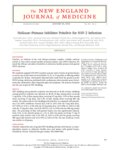 | Kriesel, John D. | Helicase-primase inhibitor pritelivir for HSV-2 infection | Background Pritelivir, an inhibitor of the viral helicase-primase complex, exhibits antiviral activity in vitro and in animal models of herpes simplex virus (HSV) infection. We tested the efficacy and safety of pritelivir in otherwise healthy persons with genital HSV-2 infection. Methods We randomly... | 2014-01-01 | |
| 67 |
 | Zhang, Kang | Heterozygous and homozygous mutations in PITX3 in a large Lebanese family with posterior polar cataracts and neurodevelopmental abnormalities | PURPOSE: The PITX3 gene, which codes for a homeobox bicoidlike transcription factor is responsible for dominant cataract and anterior segment mesenchymal dysgenesis in humans. In the current study, a family with autosomal dominant posterior polar cataract (PPC) and a PITX3 mutation that cosegregates... | Chromosomes, Human, Pair 10; Homozygote; Lod Score | 2006 |
| 68 |
 | Bernstein, Paul S. | HPLC measurement of ocular carotenoid levels in human donor eyes in the lutein supplementation era. | PURPOSE: A substantial proportion of the population at risk for visual loss from age-related macular degeneration consumes supplements containing high doses of lutein, but clinical studies to date have shown only modest and variable increases in macular carotenoid pigments in response to supplementa... | Chromatography, High Pressure Liquid; Dietary Supplements; Tissue Donors | 2007-02 |
| 69 |
 | Baehr, Wolfgang | Human interstitial retinoid-binding protein. Gene structure and primary structure | Interstitial retinoid-binding protein (IRBP) is synthesized and secreted by rod photoreceptor cells into the interphotoreceptor matrix and is known to bind retinoids and fatty acids. We have used cDNA clones encoding human IRBP to isolate a 15-kilobase genomic fragment that encompasses the complete ... | Molecular Sequence Data; Eye Proteins; Retinol-Binding Proteins; Messenger RNA | 1989-05-15 |
| 70 |
 | Bernstein, Paul S. | Human retinal pigment epithelial cell line that retains epithelial characteristics after prolonged culture | PURPOSE. A spontaneously arising, apparently transformed, cell line has been cloned from a primary culture of human retinal pigment epithelial (RPE) cells and has been subcultured more than 200 times. The similarities of these cells to human RPE cells in vivo have been determined. METHODS. The struc... | Cell Line, Transformed; Chromatography, High Pressure Liquid; Phagocytosis | 1995 |
| 71 |
 | Frederick, Jeanne M.; Thulin, Craig; Bernstein, Paul S. | Identification and characterization of a Pi isoform of glutathione S-transferase (GSTP1) as a zeaxanthin-binding protein in the macula of the human eye | Uptake, metabolism, and stabilization of xanthophyll carotenoids in the retina are thought to be mediated by specific xanthophyll-binding proteins (XBPs). A membrane-associated XBP was purified from human macula using ion-exchange chromatography followed by gel-exclusion chromatography. Two-dimensio... | Circular Dichroism; Isoelectric Focusing; Macula Lutea; Xanthophylls | 2004 |
| 72 |
 | Zhang, Kang | Identification and functional consequences of a new mutation (E155G) in the gene for GCAP1 that causes autosomal dominant cone dystrophy | 2001 | ||
| 73 |
 | Baehr, Wolfgang | Identification and light-dependent translocation of a cone-specific antigen, (Cone Arrestin) recognized by monoclonal antibody 7G6 | PURPOSE: To elucidate the antigen recognized by monoclonal antibody (mAb) 7G6, a widely used cone-specific marker. METHODS: 7G6 immunocytochemistry was performed on sections of human, primate, and bovine retina. The antigen was immunoprecipitated from human retinal lysates and purified with protein ... | Cones (Retina); Molecular Sequence Data; Phototransduction | 2003 |
| 74 |
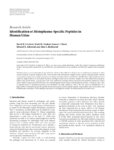 | Crockett, David K. | Identification of histoplasma -specific peptides in human urine | Histoplasmosis is a severe dimorphic fungus infection, which is often difficult to diagnose due to similarity in symptoms to other diseases and lack of specific diagnostic tests. Urine samples from histoplasma-antigen-positive patients and appropriate controls were prepared using various sample prep... | 2012-01-01 | |
| 75 |
 | Bernstein, Paul S. | Identification of lutein and zeaxanthin oxidation products in human and monkey retinas | PURPOSE: To characterize fully all the major and minor carotenoids and their metabolites in human retina and probe for the presence of the oxidative metabolites of lutein and zeaxanthin. METHODS: Carotenoids of a composite of 58 pairs of human retinas and a monkey retina were elucidated by comparing... | Mass Spectrometry; Oxidation-Reduction; Spectrophotometry, Ultraviolet | 1997 |
| 76 |
 | Digre, Kathleen B.; Kleinschmidt, Julia J.; Hanover, Rita | Idiopathic intracranial hypertension. Relationship to depression, anxiety, and quality of life | OBJECTIVE: To explore the incidence of depression and anxiety and to measure quality of life in women with idiopathic intracranial hypertension (IIH), a matched group cross-sectional study was conducted. Women with IIH (n = 28) were compared with control groups of weight- and age-matched women not d... | Intracranial Hypertension; Depression; Anxiety; Quality of Life | 2000-01-25 |
| 77 |
 | Baehr, Wolfgang; Thulin, Craig | Immunolocalization and divergent roles of phosducin and phosducin-like protein in the retina | PURPOSE: These investigations were undertaken to compare and contrast the roles of phosducin and phosducin-like protein in the retina. METHODS: Phosducin and phosducin-like protein were compared in an in vitro assay measuring their inhibition of transducin binding to light-activated rhodopsin. The t... | Antibody Specificity; Protein Binding; Rod Outer Segments | 1999 |
| 78 |
 | Baehr, Wolfgang | In vitro isoprenylation and membrane association of mouse rod photoreceptor cGMP phosphodiesterase alpha and beta subunits expressed in bacteria | We investigated the specificity of CAAX box-related isoprenylation of rod photoreceptor cGMP phosphodiesterase (PDE) subunits expressed in bacteria and the consequences of this modification on rod disk membrane association. Full-length cDNA sequences of the alpha and beta subunits of mouse PDE, inse... | Chromatography, High Pressure Liquid; Electrophoresis, Polyacrylamide Gel; Molecular Sequence Data | 1992 |
| 79 |
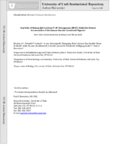 | Frederick, Jeanne M. | Inactivity of human β,β-carotene-9′, 10-′dioxygenase (BCO2) underlies retinal accumulation of the human macular carotenoid pigment | The macula of the primate retina uniquely concentrates high amounts of the xanthophyll carotenoids lutein, zeaxanthin, and meso-zeaxanthin, but the underlying biochemical mechanisms for this spatial- and species-specific localization have not been fully elucidated. For example, despite abundant reti... | 2014-01-01 | |
| 80 |
 | Frederick, Jeanne M. | Inhibitors of metalloendoprotease activity prevent K+-stimulated neurotransmitter release from the retina of Xenopus laevis. | Metalloendoprotease activity was identified in retinal homogenates using a synthetic fluorogenic metalloendoprotease substrate and specific metalloendoprotease inhibitors. The requirement of metalloendoprotease activity in neurotransmitter release was examined during the depolarization-induced relea... | Neuromuscular Junction; Neurotransmitter Agents; Membrane Fusion | 1984 |
| 81 |
 | Warner, Judith E. A. | Intermittent reversal of Complete Ptosis-EganWarner | CASE REPORT: Ptosis secondary to dense oculomotor pareses generally improves over several months, but intermittent elevation of the eyelid has not been reported. The Author's describe two patients who demonstrated intermittent involuntary monocular eyelid elevation in an eye with complete ptosis cau... | Eyelids; Ophthalmoplegia; Intraoperative Complications | 2006 |
| 82 |
 | Olson, Randall J.; Crandall, Alan S.; Caldwell, Karin D.; Jensen, Michael K. | Intraoperative crystallization on the intraocular lens surface | PURPOSE: To report a physician survey, laboratory studies, and clinical observations of intraoperative crystallization on the surface of the intraocular lens (IOL). METHOD: We sent a survey to all ophthalmologists in the states of Wyoming, Idaho, Montana, Utah, and Colorado asking whether crystalliz... | Cataract Extraction; Intraoperative Complications; Risk Factors | 1998-08 |
| 83 |
 | Olson, Randall J.; Crandall, Alan S.; Mamalis, Nick | Intraoperative miotics and posterior capsular opacification following phacoemulsification with intraocular lens insertion | BACKGROUND AND OBJECTIVES: Posterior capsular opacification (PCO) is a frequent complication following phacoemulsification with intraocular lens (IOL) implantation. A series of consecutive patients receiving capsular bag-fixated, silicone IOL implants were assessed for both incidence of PCO and the ... | Intraocular Lens; Nd:YAG Laser Capsulotomy; Miochol; Miostat; Phacoemulsification; Posterior Capsular Opacification | 1997-11 |
| 84 |
 | Kriesel, John D.; Gooch, Willis M.; Pavia, Andrew T. | Invasive sinonasal disease due to Scopulariopsis candida: case report and review of scopulariopsosis. | Sinonasal infection with fungi of the order Mucorales--termed mucormycosis or zygomycosis--is sometimes seen in immunosuppressed patients, including those with diabetic ketoacidosis and malignancy. We describe a case of invasive sinonasal infection with Scopulariopsis candida (not among the Mucorale... | Granulocyte Colony-Stimulating Factor; Itraconazole; Maxillary Sinus | 1994 |
| 85 |
 | Fuhrmann, Sabine; Zhang, Jianmin; Vetter, Monica L. | Investigation of Frizzled-5 during embryonic neural development in mouse | Cellular and tissue--tissue interactions regulate development of the central nervous system (CNS) and a paramount question is what is the nature of the signals involved in these interactions. The vertebrate eye represents an excellent and challenging CNS model because it contains multiple cell and ... | Mouse; Eye; Optic cup; Morphogenesis; Retina; Lens; Wnt; Frizzled; Pituitary | 2008 |
| 86 |
 | Baehr, Wolfgang | Isolation and characterization of cGMP phosphodiesterase from bovine rod outer segments | A simple purification method has been developed for isolation of bovine cGMP phosphodiesterase from photoreceptor rod outer segments. The enzyme is peripherally membrane bound in its native state and is present in relatively high concentrations. In the bovine photoreceptors its molar ratio to rhodop... | Enzyme Activation; Macromolecular Substances; Trypsin/pharmacology | 1979 |
| 87 |
 | Angelucci, Alessandra | Layer-specific programs of development in neocortical projection neurons | How are long-range axonal projections from the cerebral cortex orchestrated during development? By using both passively and actively transported axonal tracers in fetal and postnatal ferrets, we have analyzed the development of projections from the cortex to a number of thalamic nuclei. We report th... | Axonal Transport; Efferent Pathways; Brain Mapping | 1995 |
| 88 |
 | Baehr, Wolfgang | Lecithin-retinol acyltransferase is essential for accumulation of all-trans-retinyl esters in the eye and in the liver | Lecithin-retinol acyltransferase (LRAT), an enzyme present mainly in the retinal pigmented epithelial cells and liver, converts all-trans-retinol into all-trans-retinyl esters. In the retinal pigmented epithelium, LRAT plays a key role in the retinoid cycle, a two-cell recycling system that replenis... | Antibodies, Monoclonal; Chromatography, High Pressure Liquid; Microscopy, Fluorescence | 2004 |
| 89 |
 | Olson, Randall J. | Legacy AdvanTec and Sovereign WhiteStar: a wound temperature study | PURPOSE: To assess the wound temperature of the Sovereign WhiteStar (S-WS) (AMO) and Legacy AdvanTec (L-ADV) (Alcon) phacoemulsification systems. SETTING: John A. Moran Eye Center, Health Sciences Center, University of Utah, Salt Lake City, Utah, USA. METHODS: Phacoemulsification using 20-gauge, 30-... | Eye Burns; Wound Temperature; Phacoemulsification Systems | 2004-05 |
| 90 |
 | Baehr, Wolfgang | Light-dependent changes in G-protein binding to ROS membranes in intact Bufo retinas | Light-dependent changes in the binding of G-protein were analyzed in outer segment disk membranes obtained from photoreceptors of the toad (Bufo marinus) retina. Isolated, intact retinas, incubated in oxygenated Ringer's solution at 23 +/- 1 degree C, were subjected to various conditions of illumina... | Centrifugation, Density Gradient; Membranes; Adaptation, Physiological | 1986 |
| 91 |
 | Baehr, Wolfgang | Light-dependent redistribution of visual arrestins and transducin subunits in mice with defective phototransduction | PURPOSE: The light-dependent redistribution of phototransduction components in photoreceptor cells plays a role in light adaptation. Upon illumination, rod and cone arrestins (Arr and cArr) translocate from the inner to the outer segments while transducin subunits (Talpha, Tbetagamma) translocate in... | Phototransduction; Protein Kinases; Rhodopsin Kinase | 2003 |
| 92 |
 | Normann, Richard A.; Branner, Almut | Long-term stimulation and recording with a penetrating microelectrode array in cat sciatic nerve | We studied the consequences of long-term implantation of a penetrating microelectrode array in peripheral nerve over the time course of 4-6 mo. Electrode arrays without lead wires were implanted to test the ability of different containment systems to protect the array and nerve during contractions o... | Cats; Microelectrodes; Prosthesis Implantation; Sciatic Nerve | 2004 |
| 93 |
 | Zhang, Kang | Loss of ER retention and sequestration of the wild-type ELOVL4 by Stargardt disease dominant negative mutants | PURPOSE: Mutations in ELOVL4, a member of the fatty acid elongase (ELO) family, are responsible for autosomal dominant Stargardt-like macular degeneration. The specific role of ELOVL4 in photoreceptors and the degenerative events induced by dominant ELOVL4 mutations are not well understood. As a fir... | Macular Degeneration; Transcription Factor CHOP; Molecular Chaperones | 2005 |
| 94 |
 | Bernstein, Paul S.; Gellermann, Werner | Macular pigment Raman detector for clinical applications | Clinical studies of carotenoid macular pigments (MP) have been limited by the lack of noninvasive, objective instruments. We introduce a novel noninvasive optical instrument, an MP Raman detector, for assessment of the carotenoid status of the human retina in vivo. The instrument uses resonant excit... | Diagnosis, Computer-Assisted; Equipment Failure Analysis; Sensitivity and Specificity | 2004 |
| 95 |
 | Olson, Randall J. | Mathematical description of causative factors and prevention of elevated intraocular pressure after keratoplasty | In keratoplasty with grafts the same size as the recipient bed, tight sutures and thick recipient corneal periphery distort the angle and may collapse the filtering meshwork. This can cause very high postoperative pressures, which can be avoided by the use of donor grafts larger than the recipient b... | Keratoplasty; Trabecular Collapse; Angle Disrottion; Elevated Pressure; Aphakia; Mathematics | 1977-12 |
| 96 |
 | Fu, Yingbin | Mechanism of reductive activation of potato tuber ADP-glucose pyrophosphorylase. | The potato tuber (Solanum tuberosum L.) ADP-glucose pyrophosphorylase activity is activated by a incubation with ADP-glucose and dithiothreitol or by ATP, glucose- 1-phosphate, Ca2+, and dithiothreitol. The activation was accompanied by the appearance of new sulfhydryl groups as determined with 5, 5... | Glucosephosphates; Enzyme Activation; Adenosine Triphosphate | 1998 |
| 97 |
 | Baehr, Wolfgang | Metabolism and transactivation activity of 13,14-dihydroretinoic acid | The metabolism of vitamin A is a highly regulated process that generates essential mediators involved in the development, cellular differentiation, immunity, and vision of vertebrates. Retinol saturase converts all-trans-retinol to all-trans-13,14-dihydroretinol (Moise, A. R., Kuksa, V., Imanishi, Y... | Chromatography, High Pressure Liquid; Electrophoresis, Polyacrylamide Gel; Retinoid X Receptors | 2005 |
| 98 |
 | Olson, Randall J. | Microphaco update | Microphacoemulsification, or cataract surgery using ultrasound through two small stab incisions. Wound burn is now not a problem with AMO's Sovereign system plus Whitestar technology. | Microphacoemulsification; Wound Burn; Cataract Extraction | 2002 |
| 99 |
 | Kriesel, John D. | Miliary Tuberculosis and the postpartum state | In 1985, a resurgence of tuberculosis began in the United States. In conjunction with this resurgence, there has been an increase in the number of atypical presentations of the disease. We recently treated a patient who had disseminated tuberculosis that became manifest in the postpartum state. Wher... | Miliary tuberculosis; Postpartum | 1995 |
| 100 |
 | Normann, Richard A.; Horch, Kenneth W.; Cha, Kichul | Mobility performance with a pixelized vision system | A visual prosthesis, based on electrical stimulation of the visual cortex, has been suggested as a means for partially restoring functional vision in the blind. The prosthesis would create a pixelized visual sense consisting of punctate spots of light (phosphenes). The present study investigated the... | Visual Prosthesis; Mobility; Phosphene Simulator | 1992 |
| 101 |
 | Zhang, Kang | Molecular and developmental characterization of the heat shock cognate 4 gene of Drosophila melanogaster | The Drosophila heat shock cognate gene 4 (hsc4), a member of the hsp70 gene family, encodes an abundant protein, hsc70, that is more similar to the constitutively expressed human protein than the Drosophila heat-inducible hsp70. Developmental expression revealed that hsc4 transcripts are enriched in... | Embryo, Nonmammalian; Molecular Sequence Data | 1990 |
| 102 |
 | Baehr, Wolfgang; Rao, Narayanam V. | Molecular characterization of a third member of the guanylyl cyclase-activating protein subfamily | The mammalian retina contains at least two guanylyl cyclases (GC1 and GC2) and two guanylyl cyclase-activating proteins (GCAP1 and GCAP2). Here we present evidence of the presence of a new photoreceptor-specific GCAP, termed GCAP3, which is closely related to GCAP1. The sequence similarity of GCAP3 ... | Amino Acid Sequence; Cloning, Molecular; Gene Expression Regulation | 1999 |
| 103 |
 | Baehr, Wolfgang | Molecular characterization of human and mouse photoreceptor guanylate cyclase-activating protein (GCAP) and chromosomal localization of the human gene | Guanylate cyclase-activating protein (GCAP) is a novel Ca(2+)-binding protein that stimulates synthesis of cGMP in photoreceptors. Molecular cloning of human and mouse GCAP cDNA revealed that the known mammalian GCAPs are more than 90% similar, consist of 201-205 amino acids, and contain three ident... | Amino Acid Sequence; Base Sequence; Cloning, Molecular | 1994 |
| 104 |
 | Jones, Bryan W. | Molecular phenotyping of retinal ganglion cells | Classifying all of the ganglion cells in the mammalian retina has long been a goal of anatomists, physiologists, and cell biologists. The rabbit retinal ganglion cell layer was phenotyped using intrinsic small molecule signals (aspartate, glutamate, glycine, glutamine, GABA, and taurine) and glutama... | Aspartic Acid/metabolism; Image Cytometry/methods | 2002 |
| 105 |
 | Baehr, Wolfgang | Mouse opsin. Gene structure and molecular basis of multiple transcripts | The single copy mouse opsin gene produces five major transcripts, varying in size from 1.7 to 5.1 kilobases. The mRNAs are present at levels that vary over 2 orders of magnitude and can be detected as early as postnatal day 1. Each of the transcripts is polyadenylated and can be identified in polyso... | Polyribosomes; Restriction Mapping; Sequence Homology, Nucleic Acid | 1990 |
| 106 |
 | Angelucci, Alessandra | Multiple components of surround modulation in primary visual cortex: Multiple neural circuits with multiple functions? | The responses of neurons in primary visual cortex (V1) to stimulation of their receptive field (RF) are modulated by stimuli in the RF surround. This modulation is suppressive when the stimuli in the RF and surround are of similar orientation, but less suppressive or facilitatory when they are cross... | 2014-01-01 | |
| 107 |
 | Baehr, Wolfgang; Frederick, Jeanne M.; Church-Kopish, Jill; Howes, Kimberly | Mutant rhodopsin transgene expression on a null background | PURPOSE. To study mechanisms leading to photoreceptor degeneration in mouse models for autosomal dominant retinitis pigmentosa (adRP) based on the rhodopsin P23H mutation. METHODS. Mice of a transgenic line expressing a rhodopsin triple mutant, V20G, P23H, and P27L (GHL), were mated with rhodopsin (... | Mutant Rhodopsin; Photoreceptor Degeneration; Autosomal Dominant Retinitis Pigmentosa; Rhodopsin | 2001-03 |
| 108 |
 | Zhang, Kang; Yang, Zhenglin; Jiang, Li | Mutations in LRP5 or FZD4 underlie the common familial exudative vitreoretinopathy locus on chromosome 11q | Familial exudative vitreoretinopathy (FEVR) is an inherited blinding disorder of the retinal vascular system. Autosomal dominant FEVR is genetically heterogeneous, but its principal locus, EVR1, is on chromosome 11q13-q23. The gene encoding the Wnt receptor frizzled-4 (FZD4) was recently reported ... | Familial exudative vitreoretinopathy; FEVR; Inherited blinding disorders | 2004 |
| 109 |
 | Normann, Richard A.; Maynard, Edwin M. | Neural interface for a cortical vision prosthesis | The development of a cortically based vision prosthesis has been hampered by a lack of basic experiments on phosphene psychophysics. This basic research has been hampered by the lack of a means to safely stimulate large numbers of cortical neurons. Recently, a number of laboratories have developed a... | Neuroprosthetics; Artificial Vision; Electrode Arrays; Multielectrode Recordings; Biocompatibility | 1999 |
| 110 |
 | Normann, Richard A.; Kolb, Helga | Neural organization of the retina of the turtle Mauremys caspica: a light microscope and Golgi study | The organization of the retina of the turtle species Mauremys caspica, found in fresh water ponds of Israel, has been examined by light microscopical techniques including examination of fresh wholemount retina, one micron blue-stained vertical sections and Golgi-stained material. The anatomical find... | Turtle Retina; Photoreceptors; Golgi Technique; Amarcine Cells | 1988 |
| 111 |
 | Digre, Kathleen B.; Skuster, Denise Z. | Neurologic conditions presenting as psychiatric disorders. | Understanding underlying neuroanatomic function helps physicians to localize defects and search for treatable neurologic conditions. Neurologic conditions such as Huntington's chorea, Wilson's disease, Gille de la Tourette syndrome, brain tumors, encephalitis and meningitis, neurodegenerative condit... | Psychiatric Diagnosis; Neurologic Disease | 1992-06-15 |
| 112 |
 | Normann, Richard A.; Maynard, Edwin M. | Neuronal interactions improve cortical population coding of movement direction | Interactions among groups of neurons in primary motor cortex (MI) may convey information about motor behavior. We investigated the information carried by interactions in MI of macaque monkeys using a novel multielectrode array to record simultaneously from 12-16 neurons during an arm-reaching task. ... | Motor Cortex; Monkey; Population Coding; Movement | 1999 |
| 113 |
 | Frederick, Jeanne M. | Neurotransmitter properties of the newborn human retina. | Human retinal tissue from a newborn was examined autoradiographically for the presence of highaffinity uptake and localization of the following putative neurotransmitters: dopamine, glycine, GAB A, aspartate, and glutamate. In addition, the dopamine content of this newborn retina was measured by ... | Newborn; Human Retina; Neurotransmitter Properties; Photoreceptors | 1983 |
| 114 |
 | Zhang, Kang | New locus for autosomal dominant stargardt-like disease maps to chromosome 4 | Stargardt disease (STGD) is the most common hereditary macular dystrophy and is characterized by decreased central vision, atrophy of the macula and underlying retinal-pigment epithelium, and frequent presence of prominent flecks in the posterior pole of the retina. STGD is most commonly inherited a... | Haplotypes; Genetic Markers | 1999 |
| 115 |
 | Baehr, Wolfgang | Noninvasive two-photon imaging reveals retinyl ester storage structures in the eye | Visual sensation in vertebrates is triggered when light strikes retinal photoreceptor cells causing photoisomerization of the rhodopsin chromophore 11-cis-retinal to all-trans-retinal. The regeneration of preillumination conditions of the photoreceptor cells requires formation of 11-cis-retinal in t... | Microscopy, Fluorescence; Visual Perception; Membrane Proteins | 2004 |
| 116 |
 | Bernstein, Paul S.; Gellermann, Werner | Nonmydriatic fluorescence-based quantitative imaging of human macular pigment distributions. | We have developed a CCD-camera-based nonmydriatic instrument that detects fluorescence from retinal lipofuscin chromophores ("autofluorescence") as a means to indirectly quantify and spatially image the distribution of macular pigment (MP). The lipofuscin fluorescence intensity is reduced at all ret... | Cytology; Sensitivity and Specificity | 2006-10 |
| 117 |
 | Digre, Kathleen B. | Not so benign intracranial hypertension. | Despite many controversies, intracranial hypertension due to use of doxycycline does occur. Practitioners prescribing the tetracyclic antibiotics should be aware of the syndrome of increased intracranial pressure, and pay particular attention to the ocular fundus for papilloedema. Appropriate referr... | Venous Occusion; Venous Hypertension; Tetracycline, Doxycycline; Minocycline | 2003-03-22 |
| 118 |
 | Baehr, Wolfgang | Novel GCAP1 missense mutation (L151F) in a large family with autosomal dominant cone-rod dystrophy (adCORD) | PURPOSE: To elucidate the phenotypic and biochemical characteristics of a novel mutation associated with autosomal dominant cone-rod dystrophy (adCORD). METHODS: Twenty-three family members of a CORD pedigree underwent clinical examinations, including visual acuity tests, standardized full-field ERG... | Polymorphism, Single-Stranded Conformational; Guanylate Cyclase-Activating Proteins; DNA Mutational Analysis | 2005 |
| 119 |
 | Baehr, Wolfgang | Novel mutation (I143NT) in guanylate cyclase-activating protein 1 (GCAP1) associated with autosomal dominant cone degeneration | PURPOSE: To identify pathogenic mutations in the guanylate cyclase-activating protein 1 (GCAP1) and GCAP2 genes and to characterize the biochemical effect of mutation on guanylate cyclase (GC) stimulation. METHODS: The GCAP1 and GCAP2 genes were screened by direct sequencing for mutations in 216 pat... | DNA Mutational Analysis; Mutation, Missense; Electroretinography | 2004 |
| 120 |
 | Zhang, Kang | Novel mutation in the ELOVL4 gene causes autosomal dominant Stargardt-like macular dystrophy | PURPOSE. To conduct clinical and genetic studies in a European family with autosomal dominant Stargardt-like macular dystrophy (adSTGD-like MD) and to investigate the functional consequences of a novel ELOVL4 mutation | Macular dystrophy; ELOVL4 mutation; Genetics | 2004 |
| 121 |
 | Kriesel, John D.; Spruance, Spotswood L.; Daynes, Raymond A. | Nucleic acid vaccine encoding gD2 protects mice from herpes simplex virus type 2 disease. | Nucleic acid vaccinations with plasmids pWW65, containing the sequence for herpes simplex type 2 (HSV-2) gD2, and pRSVnt, lacking the gD sequence, were studied. Groups of mice were immunized with pWW65 alone, pWW65 plus 1,25-dihydroxyvitamin-D3 (D3), or pRSVnt. Clinical disease (vaginitis), serum an... | Mice, Inbred BALB C; Plasmids; Viral Vaccines | 1996 |
| 122 |
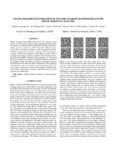 | Jones, Bryan W. | Online parameter estimation in dynamic Markov Random Fields for image sequence analysis | Markov Random Fields (MRF) have proven to be extremely useful models for efficient and accurate image segmentation.Recent literature points to an increased effort towards incorporating useful priors (shape, geometry, context) in a MRF framework. However, topological priors, considered extremely cruc... | 2012-01-01 | |
| 123 |
 | Normann, Richard A. | Oscillations in rod and horizontal cell membrane potential: evidence for feed-back to rods in the vertebrate retina | 1. Rods and horizontal cells were studied with intracellular recordings in the retina of the toad, Bufo marinus; 161 cells were from the eyecup preparation and thirty were from the isolated perfused retina. 2. Of these cells, 39% exhibited either transient or sustained oscillations of membrane poten... | Retina; Photoreceptors; Toads; Adaptation, Ocular | 1976 |
| 124 |
 | Mamalis, Nick; Nilson, Christian D. | Outbreak of toxic anterior segment syndrome following cataract surgery associated with impurities in autoclave steam moisture. | BACKGROUND: Toxic anterior segment syndrome (TASS), a complication of cataract surgery, is a sterile inflammation of the anterior chamber of the eye. An outbreak of TASS was recognized at an outpatient surgical center and its affiliated hospital in December 2002. METHODS: Medical records of patients... | Toxic anterior segment syndrome; cataract surgery; autoclave steam moisture | 2006 |
| 125 |
 | Olson, Randall J.; Pingree, Michael F.; Lundergan, Maureen K. | Penetrating keratoplasty for keratoconus: a long-term review of results and complications | PURPOSE: To study the long-term complications of penetrating keratoplasty (PKP) to evaluate current recommendations to patients with keratoconus. SETTING: John Moran Eye Center, University of Utah, Salt Lake City, Utah, USA. METHODS: Retrospective study of all PKP procedures for keratoconus performe... | Visual Acuity; Refraction, Ocular; Keratoconus; Astigmatism | 2000-07 |
| 126 |
 | Baehr, Wolfgang | Pharmacological and rAAV gene therapy rescue of visual functions in a blind mouse model of Leber congenital amaurosis | BACKGROUND: Leber congenital amaurosis (LCA), a heterogeneous early-onset retinal dystrophy, accounts for approximately 15% of inherited congenital blindness. One cause of LCA is loss of the enzyme lecithin:retinol acyl transferase (LRAT), which is required for regeneration of the visual photopigmen... | Disease Models, Animal; Genetic Vectors; Molecular Sequence Data | 2005 |
| 127 |
 | Baehr, Wolfgang | Phenolic components from the leaves of the Ginkgo tree (Ginkgo biloba L) | No summary- Article is in German. | Flavonoids; Chromatography; Phenols; Plant Extracts; Ginkgo Biloba L. | 1968-05 |
| 128 |
 | Digre, Kathleen B.; Couldwell, William T.; Amini, Amin | Photophobia in a blind patient: An alternate visual pathway. Case report. | Photophobia is a common neurological and ophthalmological symptom that has been associated with a growing number of neurosurgical conditions, especially compressive lesions. The exact signaling pathways and neurophysiological features of the disorder are not well understood; however, data from multi... | Photophobia, Blindness, Signaling Pathway, Pretectal Nuclei, Trigeminal Pathway | 2006-12-14 |
| 129 |
 | Baehr, Wolfgang; Prestwich, Glenn D. | Photoreceptor cGMP phosphodiesterase delta subunit (PDEdelta) functions as a prenyl-binding protein | Bovine PDEdelta was originally copurified with rod cGMP phosphodiesterase (PDE) and shown to interact with prenylated, carboxymethylated C-terminal Cys residues. Other studies showed that PDEdelta can interact with several small GTPases including Rab13, Ras, Rap, and Rho6, all of which are prenylate... | Fluorescence Resonance Energy Transfer; GTP Phosphohydrolases; Immunohistochemistry | 2004 |
| 130 |
 | Olson, Randall J.; Mamalis, Nick; Spencer, Terrence S. | Postoperative sterile endophthalmitis (TASS) associated with the memorylens | PURPOSE: To report 10 cases of delayed-onset acute intraocular inflammation following cataract extraction and posterior chamber implantation of the MemoryLens(R) intraocular lens (IOL). SETTING: John A. Moran Eye Center, Department of Ophthalmology, University of Utah, Salt Lake City, Utah, USA. MET... | Memory Lens; Toxic Anterior Segment Syndrome; Retrospective Studies; adverse effects | 2000-12 |
| 131 |
 | Frederick, Jeanne M. | The prenyl-binding protein PrBP/δ: A chaperone participating in intracellular trafficking | Expressed ubiquitously, PrBP/d functions as chaperone/co-factor in the transport of a subset of prenylated proteins. PrBP/d features an immunoglobulin-like b-sandwich fold for lipid binding, and interacts with diverse partners. PrBP/d binds both C-terminal C15 and C20 prenyl side chains of phototran... | 2012-01-01 | |
| 132 |
 | Baehr, Wolfgang | Primary structure and chromosomal localization of human and mouse rod photoreceptor cGMP-gated cation channel | We have determined the primary structures of the human and mouse retinal rod cGMP-gated cation channel by analysis of cDNA clones and amplified DNA. The open reading frames predicted polypeptides of 690 and 683 residues exhibiting 88% sequence similarity. Sequence comparison indicated that the rod c... | Restriction Mapping; Sequence Homology, Nucleic Acid; Chromosomes, Human, Pair 4 | 1992 |
| 133 |
 | Varner, Michael W.; Digre, Kathleen B. | Pseudotumor cerebri and pregnancy. | Pseudotumor cerebri (PTC) is most commonly seen in obese women of reproductive age. We studied 109 women with PTC between ages 16 and 44 years. In 11, PTC started during pregnancy. Thirteen women with previous diagnosis of PTC, including two of the aforementioned 11, had an additional 17 documented ... | Pregnancy Complications; Pseudotumor Cerebri; Vision disorders; Headache; Intracranial Pressure | 1984-06 |
| 134 |
 | Bernstein, Paul S.; Gellermann, Werner | Raman detection of macular carotenoid pigments in intact human retina | PURPOSE: To develop and test a novel noninvasive optical technique suitable for the objective measurement of macular carotenoid levels in human retina. METHODS: A resonance Raman scattering apparatus was constructed to measure carotenoid levels in flat-mounted human retinas and eyecups and in experi... | Rana pipiens; Spectrum Analysis, Raman; Xanthophylls | 1998 |
| 135 |
 | Frederick, Jeanne M.; Baehr, Wolfgang | Receptor for advanced glycation end products and age-related macular degeneration. | Advanced glycation end products (AGE) exacerbate disease progression through two general mechanisms: modifying molecules and forming nondegradable aggregates, thus impairing normal cellular/tissue functions, and altering cellular function directly through receptor-mediated activation. In the present... | Optic Atrophies, Hereditary; Apoptosis; Pigment Epithelium of Eye | 2004 |
| 136 |
 | Baehr, Wolfgang | Receptors for advanced glycation end products as progressive factors in age-related macular degeneration | Advanced glycation end products (AGE) exacerbate disease progression through two general mechanisms: modifying molecules and forming nondegradable aggregates, thus impairing normal cellular/tissue functions, and altering cellular function directly through receptor-mediated activation. In the prese... | Advanced glycation end products; AGE; receptor for AGE-mediated cellular activation; RAGE | 2004 |
| 137 |
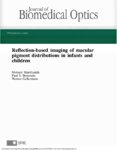 | Bernstein, Paul S. | Reflection-based imaging of macular pigment distributions in infants and children | We have developed a reflection-based capability of the RetCam® platform, an FDA-cleared pediatric retinal-imaging instrument, for the purpose of measuring macular pigment levels as well as their spatial distributions in infants and children. Our modifications include narrow-band blue-wavelength exc... | 2013-01-01 | |
| 138 |
 | Creel, Donnell J.; Leventhal, Audie G. | Retinal projections in tyrosinase-negative albino cats | Retinal projections were examined in two tyrosinase-negative albino cats using autoradiographic techniques. Cats from this colony have pink eyes; their retinal pigment epithelium, ciliary body, and iris epithelium are completely devoid of melanin pigment. Test breeding for five generations indicates... | Cats; Albinism; Vision; Autoradiography; Retina | 1982-07 |
| 139 |
 | Bernstein, Paul S. | Retinal tubulin binds macular carotenoids | PURPOSE: To investigate the biochemical mechanisms responsible for the specific uptake, concentration, and stabilization of the carotenoids lutein and zeaxanthin in the macula. METHODS: Soluble extracts of bovine retina mixed with radioactive carotenoids were purified by hydrophobic interaction, ion... | Chromatography, Gel; Electrophoresis; Xanthophylls | 1997 |
| 140 |
 | Baehr, Wolfgang | Retinoid absorption and storage is impaired in mice lacking lecithin:retinol acyltransferase (LRAT) | Lecithin:retinol acyltransferase (LRAT) is believed to be the predominant if not the sole enzyme in the body responsible for the physiologic esterification of retinol. We have studied Lrat-deficient (Lrat-/-) mice to gain a better understanding of how these mice take up and store dietary retinoids a... | Chromatography, High Pressure Liquid; Mice, Transgenic; Tissue Distribution | 2005 |
| 141 |
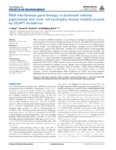 | Frederick, Jeanne M. | RNA interference gene therapy in dominant retinitis pigmentosa and cone-rod dystrophy mouse models caused by GCAP1 mutations | RNA interference (RNAi) knockdown is an efficacious therapeutic strategy for silencing genes causative for dominant retinal dystrophies. To test this, we used self-complementry (sc) AAV2/8 vector to develop an RNAi-based therapy in two dominant retinal degeneration mouse models. The allele-specific ... | 2014-01-01 | |
| 142 |
 | Kriesel, John D.; Spruance, Spotswood L. | Rocky Mountain spotted fever following cardiac transplantation. | ROCKY MOUNTAIN SPOTTED FEVER was first recognized in the early 1 900s in the Snake River Valley of Idaho and the Bitterroot Valley of western Montana.t In 1909, Howard Taylor Ricketts established the ixodid tick as the vector for the disease.2 Following the tick bite, the incubation period aver... | Male; Adult; Humans | 1993 |
| 143 |
 | Angelucci, Alessandra | Role for nitric oxide in the development of the ferret retinogeniculate projection | The ferret retinogeniculate projection segregates into eye-specific layers during the first postnatal week and into ON/OFF sublaminae, which receive inputs from either on-center or off-center retinal ganglion cells, during the third and fourth postnatal weeks. The restriction of retinogeniculate axo... | Enzyme Inhibitors; Visual Pathways; Wheat Germ Agglutinin-Horseradish Peroxidase Conjugate | 1996 |
| 144 |
 | Baehr, Wolfgang | Role of photoreceptor-specific retinol dehyrogenase (prRDH) in the retinoid cycle in vivo | The retinoid cycle is a recycling system that replenishes the 11-cis-retinal chromophore of rhodopsin and cone pigments. Photoreceptor-specific retinol dehydrogenase (prRDH) catalyzes reduction of all-trans-retinal to all-trans-retinol and is thought to be a key enzyme in the retinoid cycle. We d... | Rhodopsin, Photoreceptors; prRDH (RDH8); All-trans-RDH; A2E; Retinoid cycle; Dark adaptation | 2005 |
| 145 |
 | Olson, Randall J.; Coldwell, Karin D.; Compton, Bruce J.; Giddings, John C. | Sedimentation field-flow fractionation: a method for studying particulates in cataractous lens | It is shown that the technique of sedimentation field-flow fractionation (sedimentation [sed] FFF) can be used to determine the particle content and particle size distribution of normal and cataractous lenses. A 31-year-old normal human lens, for example, showed a particle content of 1.5% by weight ... | Fractionation; Cataractous Lens; Particulates | 1984 |
| 146 |
 | Angelucci, Alessandra | Segregation and overlap of callosal and association neurons in frontal and parietal cortices of primates: a spectral and coherency analysis. | The spatial relations between selected classes of association and callosal neurons were studied in the frontal and parietal lobes of the macaque monkey using retrogradely transported fluorescent dyes. Fast blue and nuclear yellow were injected in the left frontal (areas 4 and 6) and right posterior ... | Macaca fascicularis; Parietal Lobe; Neurons | 1989 |
| 147 |
 | Normann, Richard A.; Clark, Gregory A.; McDonnall, Daniel | Selective motor unit recruitment via intrafascicular multielectrode stimulation | Recruitment of force via independent asynchronous firing of large numbers of motor units produces the grace and endurance of physiological motion. We have investigated the possibility of reproducing this physiological recruitment strategy by determining the selectivity of access to large numbers of ... | Funtional Neuromuscular Stimulation; Microelectrode Array; Neuroprosthesis; Intrafascicular Multielectrode Stimulation; Cats | 2004 |
| 148 |
 | Digre, Kathleen B. | Selective MR imaging approach for evaluation of patients with Horner's syndrome. | PURPOSE: To assess the usefulness of MR in the evaluation of patients with Horner's syndrome. PATIENTS AND METHODS: We prospectively performed MR imaging in 33 patients with Horner's syndrome (13 preganglionic and 20 postganglionic) using a protocol specifically designed for pre- and postganglionic ... | Horner Syndrome; Magnetic Resonance Imaging; Epidemiology | 1992-01 |
| 149 |
 | Bernstein, Paul S. | Senior-Løken syndrome: a syndromic form of retinal dystrophy associated with nephronophthisis | Senior-Løken syndrome (SLS) is an autosomal recessive disease characterized by development of a retinitis (RP)- or Leber congenital amaurosis (LCA)-like retinal dystrophy and a medullary cystic kidney disease, nephronophthisis. Mutations in several genes (called nephrocystins) have been shown to ca... | 2012-01-01 | |
| 150 |
 | Askew, Eldon W.; Bernstein, Paul S. | Serum and macular responses to antioxidant supplementation verus a carotenoid-rich dietary intervention in the elderly. | The aim of this study was to observe responses of serum antioxidants, oxidative stress biomarkers, and macular carotenoid pigments to antioxidant supplements or dietary intervention in a single-masked, randomized, pilot clinical study of elderly subjects receiving antioxidant supplements or a dietar... | Macula; Serum Carotenoids; Zeaxanthin | 2006-02-01 |
| 151 |
 | Digre, Kathleen B. | Serum vitamin A concentration is elevated in idiopathic intracranial hypertension. | OBJECTIVE: The primary purpose was to investigate whether serum vitamin A concentration is associated with idiopathic intracranial hypertension (IIH). The secondary aim was to obtain pilot data regarding the amount of vitamin A ingested by patients and controls. BACKGROUND: Vitamin A is an attractiv... | Vitamin A; Retinol; Idiopathic intracranial hypertension; Chromatography | 2007-02-01 |
| 152 |
 | Normann, Richard A.; Kolb, Helga; Lasater, Eric M. | Signal integration at the pedicle of turtle cone photoreceptors: an anatomical and electrophysiological study | The morphology of the axon which connects the cell body and pedicle of turtle cone photoreceptors was studied by light and electron microscopy. The axon which contains numerous synaptic vesicles, some endoplasmic reticulum, and a few cisternae is basically filled with cytoplasm. The length of the ax... | Cone Photoreceptor, Voltage Clamp; Isolated Cells; Input Resistance; Cell Body-Pedicle Coupling | 1989 |
| 153 |
 | Normann, Richard A. | Signal transmission from red cones to horizontal cells in the turtle retina | 1. Intracellular recordings were made from L-type horizontal cells in the retina of the turtle Pseudemys scripta elegans. The responses were evoked by 500 msec pulses of 'white' light. 2. L-type horizontal cells were classified as either, 'small receptive field' s.r.f. or 'large receptive field' l.r... | Turtles; Synapses; Retina; Photoreceptors | 1979 |
| 154 |
 | Digre, Kathleen B. | Significance of CT and MR findings in sphenoid sinus disease. | Disorders of the paranasal sinuses, particularly the sphenoid sinus, can be associated with significant disorders of the optic and other cranial nerves. We examined 100 consecutive routine CT scans, 100 posterior fossa CT scans, and 100 MR scans to look for evidence of sinus disease, especially of t... | Sphenoid Sinus; Vision Disorders; Paranasal Sinus Diseases; Magnetic Resonance Imaging | 1989-05 |
| 155 |
 | Normann, Richard A.; Abbasi, Masoud; Johansson,Torbjorn | Silicon carbide enhanced thermomigration | The widespread acceptance of thermomigration technology to produce through-chip interconnects has been impaired by (i) a random walk of the Si-Al liquid eutectic inclusion as it traverses the wafer, and (ii) a ?surface barrier? which allows thermomigration of only relatively large inclusions. In ... | Silicon Dioxide; Thermometers; Transducers; Thermomigration Technology; Infrared Lamps | 1992 |
| 156 |
 | Normann, Richard A.; Campbell, Patrick K.; Jones, Kelly E.; Huber, Robert J.; Horch, Kenneth W. | Silicon-based, three-dimensional neural interface: manufacturing processes for an intracortical electrode array | A method has been developed for the manufacture of a "three-dimensional" electrode array geometry for chronic intracortical stimulation. This silicon based array consists of a 4.2 x 4.2 x 0.12 mm thick monocrystalline substrate, from which project 100 conductive, silicon needles sharpened to facilit... | Electric Stimulation; Electrodes, Implanted; Sensory Cortex; Intracortical Electrode Array | 1991 |
| 157 |
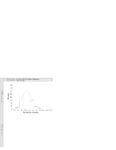 | Bernstein, Paul S. | Skin carotenoid status measured by resonance Raman spectroscopy as a biomarker of fruit and vegetable intake in preschool children | Background/Objective: Dietary assessment in children is difficult, suggesting a need to develop more objective biomarkers of intake. Resonance Raman spectroscopy (RRS) is a noninvasive, validated method of measuring carotenoid status in skin as a biomarker of fruit/vegetable intake. The purpose of t... | 2012-01-01 | |
| 158 |
 | Levine, Edward M. | Sonic hedgehog promotes rod photoreceptor differentiation in mammalian retinal cells in vitro. | The hedgehog gene family encodes secreted proteins important in many developmental patterning events in both vertebrates and invertebrates. In the Drosophila eye disk, hedgehog controls the progression of photoreceptor differentiation in the morphogenetic furrow. To investigate whether hedgehog prot... | Sonic hedgehog; Indian hedgehog; Desert hedgehog; Retina; Mitogenesis; Differentiation; Rod Photoreceptor | 1997-08-15 |
| 159 |
 | Zhang, Kang | Spectrum and frequency of FZD4 mutations in familial exudative vitreoretinopathy | Mutations in the frizzled-4 gene (FZD4) have recently been associated with autosomal dominant familial exudative vitreoretinopathy (FEVR) in families linking to the EVR1 locus on the long arm of chromosome 11. The purpose of this study was to screen FZD4 in a panel of 40 patients with FEVR to ident... | Frizzled-4 gene; FZD4; Mutation; autosomal dominant familial exudative autosomal dominant familial exudative; FEVR | 2004 |
| 160 |
 | Normann, Richard A. | Statistical encoding model for a primary motor cortical brain-computer interface | A number of studies of the motor system suggest that the majority of primary motor cortical neurons represent simple movement-related kinematic and dynamic quantities in their time-varying activity patterns. An example of such an encoding relationship is the cosine tuning of firing rate with respect... | Discrete Distribution; LN Model; Neural Decoding; Neuroprosthetics; Sequential Monte-Carlo Filter | 2005 |
| 161 |
 | Larson, Scott A. | Strabismus surgery complications: prevention and management | Strabismus surgery is increasingly becoming a subspecialty domain, especially with cyclovertical muscles, restricted muscles, or reoperations. While is impossible to completely eliminate complications from strabimus surgery, it is possible to minimize their occurrence and significance by proper prev... | Malignant hyperthermia; Overcorrection; Strabismus; Surgery; Undercorrection | 2003 |
| 162 |
 | Normann, Richard A.; Shah, Maulik R. | Study of printed spiral coils for neuroprosthetic transcranial telemetry applications | We have explored the use of printed spiral coils (PSC's) for neuroprosthetic transcranial telemetry applications. We fabricated two-dimensional PSC's on a thin (25 microns) polyimide substrate using copper (35 microns) as a conducting material. All the coils had a fixed inner diameter of 1.0 cm. We ... | Blindness; Neuroprosthesis; Transcranial Telemetry System; Prosthesis Design | 1998 |
| 163 |
 | Mamalis, Nick; Kleinmann, Guy; Chew, Jesse; Apple, David J. | Suturing a tear of the anterior capsulorhexis | AIM: To describe a new technique of suturing a tear in the anterior capsulorhexis. METHODS: Continuous curvilinear capsulorhexis (CCC) with lens removal was done in five fresh cadaver eyes. The diameter of the CCC was measured with a calliper. Using the same calliper a tear of the CCC was created wh... | Continuous curvilinear capsulorhexis; intraocular lens implantation; tear | 2006 |
| 164 |
 | Normann, Richard A.; Muller, Jay F.; Kolb, Helga | Synaptic inputs to physiologically defined turtle retinal ganglion cells | Two physiologically distinct, HRP-marked turtle retinal ganglion cells were examined for their morphology, GABAergic, glycinergic, and bipolar cell synaptic inputs, using electron-microscopic autoradiography and postembedding immunocytochemistry. One cell was a color-opponent, transient ON/OFF gangl... | Turtles; Neural Pathways; Synapes; Retinal Ganglion Cells | 1991 |
| 165 |
 | Swallow, Charles E.; Tsuruda, Jay S.; Digre, Kathleen B.; Glaser, Matthew J.; Davidson, H. Christian; Harnsberger, H. Ric | Terson syndrome: CT evaluation in 12 patients. | PURPOSE: Terson syndrome may be overlooked in the acute setting and often requires ophthalmologic intervention to prevent long-term visual loss. In this syndrome, vitreous or retinal hemorrhage results from an abrupt rise in intracranial pressure, leading to retinal venous hypertension and intraocul... | Retinal Hemorrhage; Visual Acuity; Vitreous Hemorrhage | 1998-04 |
| 166 |
 | Normann, Richard A.; Johansson,Torbjorn; Abbasi, Masoud; Huber, Robert J. | Three-dimensional architecture for a parallel processing photosensing array | A three-dimensional architecture for a photosensing array has been developed. This silicon based architecture consists of a 10 x 10 array of photosensors with 80 microns diameter, through chip interconnects to the back side of a 500 microns thick silicon wafer. Each photosensor consists of a 300 x 3... | Retina; Optics; Silicon; Photosensing | 1992 |
| 167 |
 | Olson, Randall J.; Spencer, Terrence S.; Mamalis, Nick | Three-year clinical comparison of 3-piece AcrySof and SI-40 silicone intraocular lenses | PURPOSE: To compare the 3-year performance of the 3-piece AcrySof (Alcon) and the SI-40 silicone (Allergan) intraocular lenses (IOLs). SETTING: John A. Moran Eye Center, University of Utah, Salt Lake City, Utah, USA. METHODS: In this retrospective study, patients with no complications and at least a... | Acrylic Resins; Silicone Elastomers; Prosthesis Design; Postoperative Complications; Patient Satisfaction; Cataract | 2002-07 |
| 168 |
 | Baehr, Wolfgang | Tissue-specific expression in transgenic mice directed by the 5'-flanking sequences of the human gene encoding interphotoreceptor retinoid-binding protein | Interphotoreceptor retinoid-binding protein (IRBP) is an extracellular protein that has been suggested to participate in the visual process as a carrier for visual retinoids. A chimeric gene composed of the human IRBP promoter fused to the bacterial reporter gene chloramphenicol acetyltransferase (C... | Restriction Mapping; Nucleic Acid Hybridization; Mice; Gene Expression | 1990-05-25 |
| 169 |
 | Crandall, Alan S. | Torn posterior capsule: prevention, recognition and management | Modern cataract surgery performed with phacoemulsification allows meticulous intraocular control and minimal incision size, but has the inherent risk of capsular rupture. Therefore, surgeons performing cataract surgery will inevitably face the complication of a torn posterior capsule. Torn posteri... | Capsulorrhexis complications; Phacoemulsification; Posterior capsular tears; Shallow anterior chamber; Suprachoroidal hemorrhage; Vitrectomy | 1999 |
| 170 |
 | Bernstein, Paul S. | Transformations of selected carotenoids in plasma, liver, and ocular tissues of humans and in nonprimate animal models | PURPOSE: To determine the stereochemistry of carotenoids in human ocular tissues in comparison with plasma and liver and to elucidate the possible transformations of dietary (3R,3'R,6'R)-lutein and (3R,3'R)-zeaxanthin in the eye. Similarly, to characterize the carotenoid profiles in the eye tissues,... | Chromatography, High Pressure Liquid; Stereoisomerism; Xanthophylls | 2002 |
| 171 |
 | Kriesel, John D.; Spruance, Spotswood L. | Treatment of herpes simplex labialis. | Recurrent herpes simplex labialis is associated with mild morbidity, but remains a significant problem for people with frequent and/or severe recurrences. Both topical and peroral episodic antiviral treatments of recurrences are modestly effective at reducing the duration of signs and symptoms. Rece... | Randomized Controlled Trials; Steroids; Drug Administration Routes | 2002 |
| 172 |
 | Baehr, Wolfgang | Trilateral tumors in four different lines of transgenic mice expressing SV40 T-antigen | PURPOSE. A line of transgenic mice containing the simian virus (SV) 40 T-antigen (T-ag) gene driven by the beta-luteinizing hormone (BLH) promoter developed bilateral retinoblastoma and primitive neuroectodermal tumors (PNET) of the midbrain. Midbrain tumors arose from the subependymal layer of the ... | Mice, Transgenic; Retinol-Binding Proteins; Eye Proteins | 1996 |
| 173 |
 | Frederick, Jeanne M. | Uncoordinated (UNC)119: Coordinating the trafficking of myristoylated proteins | The mechanism by which myristoylated proteins are targeted to specific subcellular membrane compartments is poorly understood. Two novel acyl-binding proteins, UNC119A and UNC119B, have been shown recently to function as chaperones/co-factors in the transport of myristoylated G protein a-subunits an... | 2012-01-01 | |
| 174 |
 | Olson, Randall J. | Update on a long-term, prospective study of capsulotomy and retinal detachment rates after cataract surgery | PURPOSE: To evaluate the retinal detachment risks and neodymium:YAG (Nd:YAG) capsulotomy rates associated with different cataract approaches and intraocular lens (IOL) styles in a long-term,prospective clinical study. SETTING: Clinical practice of 1 ophthalmologist, Fort Collins, Colorado, USA. METH... | Cataract Extraction; Laser Therapy; Retinal Detachment; Risk Factors | 2000-07 |
| 175 |
 | Crockett, David K. | Utility of gene-specific algorithms for predicting pathogenicity of uncertain gene variants | The rapid advance of gene sequencing technologies has produced an unprecedented rate of discovery for genome variation in humans. A growing numbered of authoritative clinical repositories archive gene variants and disease phenotype, yet there are currently many more gene variants that lack clear ann... | 2012 | |
| 176 |
 | Normann, Richard A. | Visual Neuroprosthetics: Functional Vision for the Blind | Resent progress in materials and microfabrication technologies have allowed researchers to reconsider the prospect of providing a useful visual sense to the profoundly blind. This will be accomplished by electrically stimulating their visual systems via an array of implanted microelectrodes. T... | Visual Neuroprosthetics; Vision; Blindness | 1995-01 |
| 177 |
 | Olson, Randall J. | Wound complications associated with incision enlargement for foldable intraocular lens implantation during cataract surgery | PURPOSE: To determine the relationship between various intraocular lens (IOL) types and the incidence of unwanted light images. SETTING: The Moran Eye Center, University of Utah, Salt Lake City, Utah, USA. METHODS: A telephone questionnaire was administered to 302 postoperative patients who had rece... | Cararact Surgery; Incision Enlargement; Wound Complications; Vision Disorders | 2000-06 |
1 - 200 of 177
